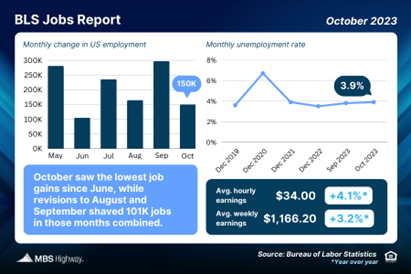
The Bureau of Labor Statistics (BLS) reported that there were 150,000 jobs created in October versus the 180,000 forecasted, which is the lowest amount since June. Revisions to August and September also shaved 101,000 jobs in those months combined. The unemployment rate rose from 3.8% to 3.9%.
What’s the bottom line? There are two reports within the Jobs Report and there is a fundamental difference between them. The Business Survey is where the headline job number comes from, and it's based predominately on modeling and estimations.
In fact, one of the biggest reasons we saw job gains last month was the birth/death model, where the BLS estimates new business creation relative to closed businesses and how many jobs this created. In October, this modeling added 412,000 jobs but it’s hard to believe that many businesses were started last month in the current economic climate, especially given the cost of capital.
The Household Survey, where the Unemployment Rate comes from, is considered more real-time because it’s derived by calling households to see if they are employed. This survey has its own job creation component and it told a completely different story, showing 348,000 job losses.
Average weekly hours worked also declined slightly, which is important because one of the ways businesses cut costs is to cut the number of hours worked. In fact, workers have lost half an hour on average since the beginning of the year. While this doesn’t sound like much, across 168 million people in the labor force, it equates to 2 million job losses on its own.